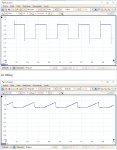Hi.
I am testing this circuit and it works well with PWM and with a digital signal with High and Low levels (digitalWrite of arduino), but I have problems to increase the frequency to which I want the led to work (infrared of 905nm). When the pulse width is 1msg, it almost no longer emits and at that point it goes off.
I have tested with these three FETs (IRF530, IRF520N and FQP50N06L) and the same thing happens and the voltage is 7.6v. In the following image I show the voltage wave on pin 13 output of ESP32 at 3.3v and the Gate pin of the FET (this voltage decreases with increasing frequency and the waveform is not square).
Thanks
View attachment 63837




